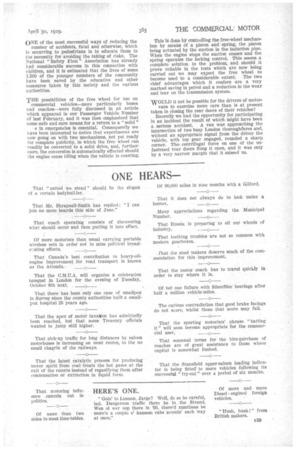LOOSE LEAVES
Page 48

Page 49

If you've noticed an error in this article please click here to report it so we can fix it.
works of the Associated Equipment Co., Ltd., at Southall, is full of interest, as the organization for production is remarkably complete. One of the most striking portions of the equipment is the mile-long ropeway which is utilized for carrying work in progress between the 250 or so machine tools in one of the main groups, the articles to be transported being placed into steel barrels for the purpose. By the use of this conveyor one progress man is able to meet the demands of all these machines and the power required is not excessive, the rope being driven by a 5 hp. electric motor.
Mr. G. Rushton, the general manager, mentioned to us last week that even the manufacturers of ropeways of this description did not think the idea was practicable, owing to the rope stretch which might occur, but a special device is provided to take this up and the arrangement is eminently successful. A TOUR around the
DIESEL advance in the U.S.A. is indicated by the progress of the Packard Co., which is laying down a new factory for the production of aeroplane engines working on this principle. It is stated that the engine evolved weighs less than 3 lb. per b.h.p. and is capable of withstanding cylinder pressures exceeding 1,200 lb. per sq. in., the compression ratio being 18 to 1 and the speed 1,700 r.p.m. to 2,000 r.p.m.
IS it possible to avoid accidents by careful driving?
is a question often asked. It has become quite a stock phrase to speak of the "other fool on the
c18
road" as being responsible, but, as an example of what can be achieved by care, we would draw attention to the presentation recently of 50 gold medals to the drivers of public-service vehicles who have not had an accident for 10 years.
We have been driving motorcycles, cars and lorries since 1908, and our only exploit so far has been the tipping up of a costermonger's barrow laden with fruit. So was the language which resulted I IT is a common cry in many walks of life that the designer, or other person from whose brain originates an idea of commercial value, is apt to be out of touch with the actual user of his product. This accusation is frequently levelled against the designers of motor vehicles, particularly by operating engineers and others connected with the use and maintenance of commercial motors.
An interesting contradiction of this is seen in the case of the Edge Engineering Works, Ltd., which concern handles conversion parts for Ford chassis. The design of these fitments is the outcome of considerable practical experience in the use of Ford vehicles for general carrying work, a fleet of over 100 of this make being operated by an allied concern.
SO certain goods vehicles in France are to be
equipped with taximeters. The idea appears to hold out some interesting possibilities, but we hope, if the idea develops in this country, that there will be no "crawlers " looking for that ton of goods. If so, the police will soon be getting busy. ONE of the most successful ways of reducing the number of accidents, fatal and otherwise, which is occurring to pedestrians is to educate them to the necessity for avoiding the taking of risks. The National "Safety First" Association has already had considerable success in this connection with children, and it is estimated that the lives of some 1,500 of the younger members of the community have been saved by the educative and other measures taken by this society and the various authorities.
THE possibilities of the free wheel for use on commercial vehicles—more particularly buses and coaches—were fully discussed in an article which appeared in our Passenger Vehicle Number of last February, and it was then emphasized that some safe and sure means for a return to a " solid " e in emergencies is essential. Consequently we have been interested to notice that experiments are now going on with two mechanisms, not yet ready for complete publicity, in which the free wheel can readily be converted to a solid drive, and, furthermore, the conversion is automatically effected should the engine cease idling when the vehicle is coasting. This'is done by controlling the free-wheel mechanism by means of a piston and -spring, the piston being actuated by the suction in the induction pipe. When the engine stops the suction ceases and the spring operates the locking control. This seems, a complete solution to the problem, and should it prove reliable in the tests which are now being carried out we may expect the free wheel to become used to a considerable extent. The two chief advantages which it confers are a very marked saving in petrol and a reduction in the wear and tear on the transmission system.
WOULD it not be possible for the drivers of motor vans to exercise more care than is at present taken in closing the rear doors of their vehicles? Recently we had the opportunity for participating in an incident the result of which might have been a serious accident. A van was approaching the intersection of two busy London thoroughfares and, without an appropriate signal from the driver the vehicle, with top gear engaged, rounded a sharp corner. Thecentrifugal force on one of tile unfastened rear doors flung it open, and it was only by a very narrow margin that it missed us.




























































































































